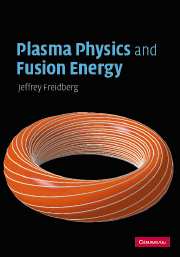Book contents
- Frontmatter
- Contents
- Preface
- Acknowledgements
- Units
- Part I Fusion power
- 1 Fusion and world energy
- 2 The fusion reaction
- 3 Fusion power generation
- 4 Power balance in a fusion reactor
- 5 Design of a simple magnetic fusion reactor
- Part II The plasma physics of fusion energy
- Appendix A Analytical derivation of 〈ς v〉
- Appendix B Radiation from an accelerating charge
- Appendix C Derivation of Boozer coordinates
- Appendix D Poynting's theorem
- Index
- References
4 - Power balance in a fusion reactor
Published online by Cambridge University Press: 14 May 2010
- Frontmatter
- Contents
- Preface
- Acknowledgements
- Units
- Part I Fusion power
- 1 Fusion and world energy
- 2 The fusion reaction
- 3 Fusion power generation
- 4 Power balance in a fusion reactor
- 5 Design of a simple magnetic fusion reactor
- Part II The plasma physics of fusion energy
- Appendix A Analytical derivation of 〈ς v〉
- Appendix B Radiation from an accelerating charge
- Appendix C Derivation of Boozer coordinates
- Appendix D Poynting's theorem
- Index
- References
Summary
Introduction
Based on the results derived in Chapter 3 it is now possible to assemble all the sources and sinks that contribute to the overall power balance in a fusion reactor. Chapter 4 describes the construction and analysis of such a power balance model. The goal is to determine quantitatively the requirements on pressure, density, temperature, and energy confinement of the D–T fuel so as to produce a favorable overall power balance in a reactor: Pout ≫ Pin.
Clearly, power balance plays a crucial role in determining the desirability of magnetic fusion as a source of electricity. An analysis of power balance determines the ease or difficulty of initiating fusion reactions. Specifically, how much external power must be supplied, either initially or continuously, to produce a given amount of steady state fusion power? The input power required must be sufficiently low in comparison to the output power in order that a large net power is produced – this is the basic requirement of a power reactor.
Basic power balance for a magnetic fusion reactor involves the analysis of the 0-D form of the law of conservation of energy from fluid dynamics. The general procedure for deriving the 0-D energy equation is the first topic discussed in Chapter 4. This is followed by a detailed analysis of the 0-D model, leading to quantitative conditions on the pressure, temperature, density, and energy confinement that must be satisfied in order to achieve a favorable power balance.
- Type
- Chapter
- Information
- Plasma Physics and Fusion Energy , pp. 60 - 84Publisher: Cambridge University PressPrint publication year: 2007



